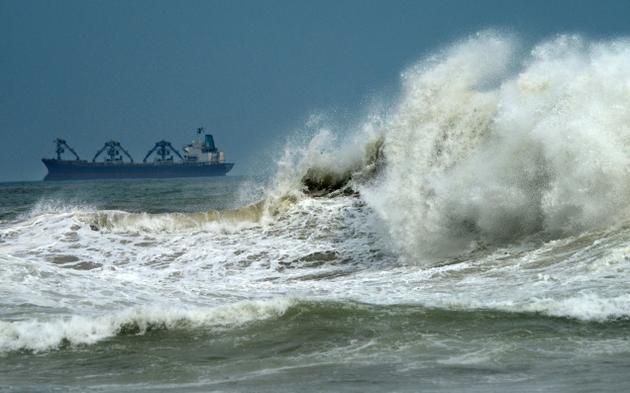
Bhubaneswar/New Delhi, Oct 12: Touching wind speeds of 210-220 km an hour, Cyclone Phailinis set to hit the Odisha coast between Paradip and Kalingapatnam with full fury on Saturday evening, whipping up a storm surge up to 10 feet above the tide level posing a threat to low-lying villages.
Anticipating the cyclone's fury, the state government began Odisha's biggest ever evacuation of shifting more than three lakh people out of harm's way as chief ministerNaveen Patnaik promised there would be zero casualties. The evacuation is expected to be complete by Saturday morning.
Met sources said the cyclone's exact landfall is likely to be around the popular beach destination of Gopalpur and coastal Odisha as well as inland areas are expected to receive heavy rainfall likely to last till Sunday.
Although the Met is not categorizing Phailin as a "super cyclone" as it is yet to cross the 220 kmph barrier, there is little doubt that Odisha was bracing for a battering with the storm reported just 400 km south east of Gopalpur at 9pm on Friday.
Foreign agencies claimed Indian authorities are underestimating Phailin, quoting London-based Tropical Storm and US Navy's joint typhoon warning centre as forecasting winds up to 315 kmph. Indian agencies, however, said wind speeds are much lower.
The impact of Phailin is expected to be narrow-focused, increasing the prospects of localized damage although a part of the impact zone is hilly and can help dissipate the storm. While the area under threat is not heavily built up, there are large fishing communities exposed to the storm fury. If the storm's arrival coincides with high tide, the water levels will be higher.
Phailin's effects are likely to be widespread, inundating not only large parts of northern Odisha, but also causing rainfall in Jharkhand, Chhattisgarh and east Madhya Pradesh. The rains are likely to be heavy and continuous.
In Delhi, home secretary ministry Anil Goswami chaired a meeting of the national executive committee (NEC), the executive body of National Disaster Management Authority (NDMA) comprising secretaries of 14 ministries and defence brass, to review the preparedness for cyclone Phailin.
Phailin, described in Met department bulletins as a "very severe cylonic storm" approaching with wind speed of 210-220 km per hour, is likely to make landfall around 5.00-5.30 pm on Saturday, with the region up to 5-10 km from the coast between Kalingapatnam and Paradip, bearing the brunt.
As many as 80,000-90,000 people have already been evacuated from the coast in Odisha, and an equal number are expected to be moved out before the Phailin landfall. Andhra Pradesh too has evacuated 65,000 people so far.
As many as 950 National Disaster Response Force (NDRF) personnel, equipped with 80 boats, have taken position at key locations near the Odisha coast and another 550 NDRF men, along with 37 boats, are deployed in coastal areas of Andhra Pradesh, NDMA vice-chairman M Shashidhar Reddy said on Friday.
Ganjam district is likely to be worst-hit. Other coastal districts falling within 75 km radius of the eye of the storm would also be impacted. "The exact landfall destination of the cyclone can be known once it comes nearly 200 km from the coast. Phailin's movement however indicates that the situation would not be like the 1999 super cyclone during which the storm lay stationery over the coastal areas for nearly 24 hours and caused a sea surge of about 30 ft. This time 10 ft high wave is expected. More so, the expected landfall area being hilly, the impact of the cyclone would be less and weaken quickly," IMD Bhubaneswar centre director Sarat Sahu said.
Not leaving anything to chance, the state government began evacuating people from coastal districts of Ganjam, Khurda, Puri, Jagatsinghpur and Kendrapada. Those who refused to leave their homes were forcibly taken to safer places. "There are 247 cyclone shelters and 10,000 concrete schools identified to house the villagers. We want to complete the evacuation by Saturday morning, particularly in Ganjam district which is likely to bear the brunt of the cyclone," special relief commissioner P K Mohapatra said.
The central government has dispatched 10 helicopters, four Cheetah helicopters and two MI-17 and AN-32 planes to help the state government in rescue and relief operations. The government's measures notwithstanding, thousands of people from the coastal region were rushing to railway stations and bus stops to escape the cyclone.
The state tourism department on Friday asked more than 200 tourists residing in the government-run Panthanivas located in coastal districts to leave. It also cancelled all bookings for nearly a week.
Chief minister Naveen Patnaik appealed to people not to be panic. He said the government is 'alive to the situation' and have initiated all possible measures for safety of people. He warned black-marketeers and hoarders and said the government would take strong action against them.
Worried over large-scale panic buying, consequent hoarding and escalation of prices of essential commodities, the state government on Friday conducted raids at several trading houses in Bhubaneswar and Cuttack and sealed the godowns.





Comments
Add new comment